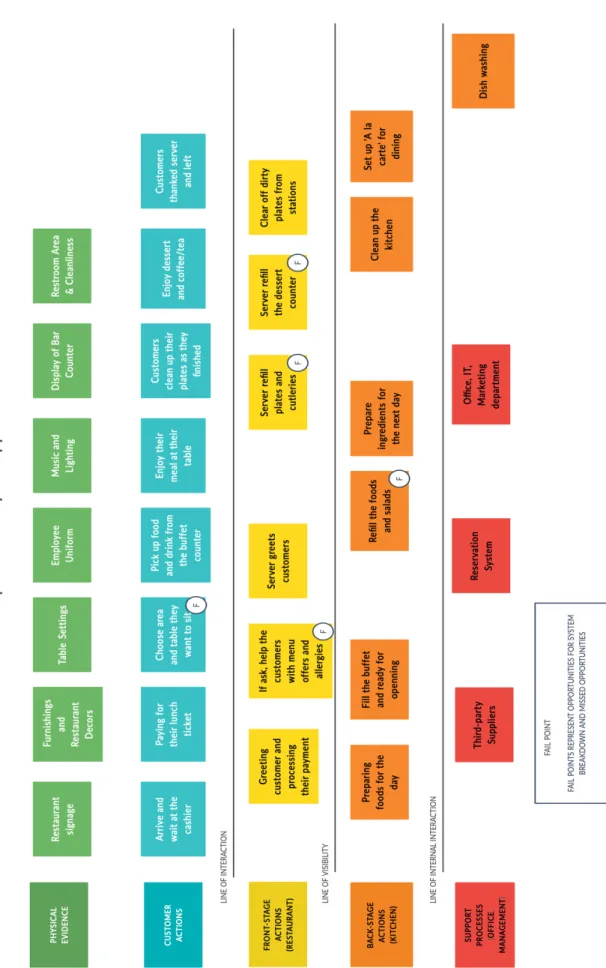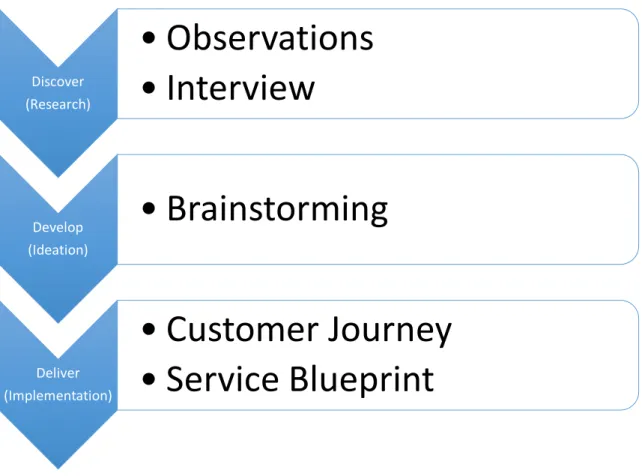The blueprint can be used as a guideline for new employees to understand the service process of the restaurant at the beginning of their employment. When both the backstage and frontstage actions processed were performed, the writers connected them and created the service blueprint for the restaurant. With the information gathered, in the last part the authors will present the customer journey and then the service blueprint of the restaurant.

Service in hospitality industry
Definition of Service
The First Industrial Revolution in the second half of the eighteenth century was known as the period of transition to machine manufacturing. Frederick Winslow Taylor, a pioneer in this field, strove to improve mass production efficiently and productively. High productivity in mass production requires fewer workers to do the same amount of work, therefore this reduction in labor turns into another sector: the service industry.
Service’s characteristics
If goods are produced, sold and consumed, service is the opposite: it is sold, produced and consumed. However, service is inseparable because it is produced and consumed at the same time. Demand for service naturally varies at different times of the day, season or year and service sector.
Service Quality
Definition of Service Quality in hospitality industry
In the next part, the authors will present the definition of service quality to find out how to improve and maintain service quality. The perceived service quality is excellent or poor, depends on the gap between the customer's expectation and their perceived service.
Dimensions of Service Quality
This aspect is a priority for service companies that provide supposedly high-risk services, such as hospitals, security or lawyers. This is crucial in businesses that have high customer involvement, such as hotels, restaurants or spas. Metters, King-Metters & Pullman (2003) referred to Zeithaml, Parasuman and Berry's (1985) survey of over 1,900 customer participants from various service companies on the five dimensions of service quality.
Gap model of Service Quality
After a correct vision of customer expectations, a service design with specific standards and priorities should be created. Other useful service planning tools such as the service plan can be used in this process. The service design model will ensure that everyone involved shares the same concept based on customer expectations.

Service Design Theories
Service design as defined by Hollins (2006) is the process of planning and organizing a service in order to improve the quality of the interaction between users and service providers. And what every situation, these explanations of service design can be useful and informative, but they are only part of the big picture. Service design can be explained or seen as a mindset, as a toolkit, as a process, as a cross-disciplinary language, or as a management approach.
Service design is ordered because it is a series of steps and processes that make up a service experience. For example, journey mapping is still more visible and popular in service design. And finally, service design is holistic in the sense that it combines several concepts into one word.
The purpose of service prototypes is to explore, evaluate, and communicate ideas within the service design process through various activities. A successful project involves finding a good combination of these tools to improve the service design process. The framework of service design according to Stickdorn et al. 2018) is not fixed and there is no one process to govern them all.
The 'This Is Service Design' framework developed by Stickdorn et al. 2018) includes four core activities such as research, ideation, prototyping and implementation.

Discover (Research stage)
- Theory of Observation
- Observation implementation and results
- Theories of Interview
- Semi-Structured Interview process and result
Non-participant observation or shadowing, a day in the life, or at work is used by one of the authors to observe and map the customer journey from the front stage of the restaurant. While the non-standardized interview can be conducted in many ways and the level depends on the purpose of the research. The advantage of the non-standardized interview is that a lot of information can be gathered.
It is important that the nature of the interview is consistent with the research purpose, research question(s) and objectives. The order of questions may also be different depending on the flow of the conversation. These aspects are related to: the appearance of the interviewer in the interview, the nature of the comments for the open interview, the approach to.
The semi-structured interview was conducted at the Factory Kamppi restaurant by one of the authors with the kitchen supervisor. Each cook's duty for a day will be different, so the whole kitchen covers most of the workload to be done. There is also a booking list of the restaurant where he can see all bookings of customers for lunch for the next three to four weeks.
The office will handle most of the bookings for events and catering and provide the information to both the kitchen and front stage.

Develop (Ideation Stage)
Brainstorming
Brainstorming has become one of the most well-known tools for generating creative ideas in business and academic environments. There are also many other brainstorming ideas that have evolved from Alex Osborne's original basics. Before a brainstorming session, Osborn recommended that each participant should have prior knowledge and understanding of the topic, which is called an isolated idea.
After the session, all the ideas were collected and sorted by a manager to choose which ideas to implement. In other words, as defined by the Yale study, individual brainstorming took place before and after the group brainstorming session. There are four basic rules that were laid down by Alex Osborn about implementing a brainstorming session.
The purpose of this rule is to keep all judgments out of the brainstorming process, as all ideas are considered later. Third, the brainstorming method encourages participants to think outside the box and contribute all sorts of ideas, even the craziest ones are welcome.
Process and Result of Brainstorming
In the theory section on dimensions of service quality, it was mentioned that the majority of customers' assessment of the quality of any service based on five elements. First, customers expect to receive the same quality of service on every visit and at any time of day. In the buffet counter, the authors suggest adding a small food sign next to each dish to help customers know what that dish is.
During the drawing service blueprint process, the authors realized that the information flow between the kitchen and the restaurant is extremely important. Any miscommunication or misunderstanding in the process can disrupt the service process, which is sure to cause irritation and delay for the customers. In the blueprint, the authors decide to include failure points where the restaurant's communication could be compromised.
There are several points of failure in the restaurant that can cause such a delay or irritation to customers. When the food runs out, if it's during rush hour, it usually won't be a problem because most of the staff are very focused on rush hour. Another point of failure is when a portion of food runs out completely and needs to be changed to a new dish that is not included in the menu that day.
The kitchen staff should inform the front staff, especially the cashier, to change the display menu for future customers so that the customers do not have any confusion about the food.
Deliver (Implementation Stage)
Customer Journey
The starting point of the map is when the customer was looking for a restaurant for lunch in the city center. Some pain points were discovered, which is very useful for developing the customer service process and creating the final service plan for the restaurant. The customer journey at Factory Restaurant has five main stages: Awareness, Consideration, Decision, Experience and Advocacy.
These stages illustrate a customer when he or she comes in needing to find a place to eat lunch. However, no matter how many different stages and points interact, the restaurant must ensure that customers have similar ideas about the concept and service of the restaurant. It is always quite dangerous if the marketing does not match the concept and quality of the real service, because it can raise the expectations of the customers and disappoint them after the experience.
After the observation and brainstorming phase, the authors define different goals and motivation of the customer when choosing restaurant Factory. Finally, they can come more than once a week because the menu changes daily and they work near the restaurant. From that point of view, the authors hypothesize that Kamppi restaurant's target customers will expect fast and effective service speed, variety of choices, consistent service quality, and reasonable price because they can come regularly.
Overall, the customer journey map has visually illustrated what a customer's experience with Restaurant Factory is like.

Service blueprint
The service blueprint can be divided into four main parts, separated by three lines; line of interaction, line of visibility and line of internal interaction. The second part is between the line of interaction and the line of visibility that encompass the front line activities of the restaurant. And the last part is the supporting processes of the restaurant, which is at the bottom of the service blueprint and behind the line of internal interaction.
The customer actions are a series of steps where customers will interact with the frontline employee to use the service at the restaurant. The second part of the plan is that the frontstage actions include what customers see and who they interact with. This part includes all activities in the restaurant's kitchen, washing area and office work.
These failing points if not given enough attention will easily cause irritation to the customers while experiencing the service of the restaurant. The service blueprint will serve as a service card of Factory Kamppi restaurant and can be used by the restaurant management for different purposes. To draw the service blueprint for the restaurant, there are two types of data that needed to be collected.
The non-participant observation is carried out by one of the authors at the restaurant with the aim of collecting and defining the customers' point of contact when they use the service. The purpose of this method is to gather information and knowledge about the backstage actions and support processes in the restaurant. The final service plan created in this thesis will be a valuable asset to the restaurant in the future.




